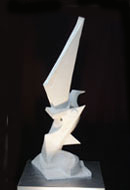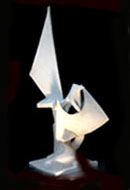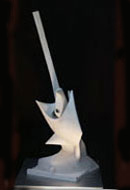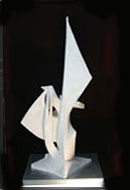



"Vogelschiff" (Bird Ship)
"Vogelschiff" was photographed by Ernst Schwitters in London during the war; the optics of his Leica were clear (50mm lens); four good photographs were available.




Photos of the reconstruction
Ernst Schwitters gave a precise description of the set-up in the kitchen where he photographed the sculpture:
The "Bird Ship" stood on a metalled box placed on a stool;
to take the photos, Ernst Schwitters turned the sculpture 90° each time, and leant his head against a wall-cupboard;
that is why the photographic angle of three of the four photos is identical; for the fourth, he lowered the camera by 3 cm (why?).Thus the preconditions for a precise reconstruction were given.
The rest was a matter of applied geometry and its translation into three dimensions...The points defined on paper were translated into spatial terms using a kind of "cage", an iron frame made of slats and rods which enabled an absolutely precise determination of each point on the sculpture according to its spatial co-ordinates (x,y,z).
As in the reconstruction of the MERZ Building, Peter Bissegger attempted to re-enact the working methods of Kurt Schwitters as far as possible, for instance by hanging fabric soaked in plaster on rails, knocking boxes out of shape, or squashing and plastering a rubber ball.Dimensions of the reconstruction: 0.40m x 1.17m x 0.65m
How did this sculpture get lost?
Kurt Schwitters left the "Bird Ship" and the "Reclining Figure" in the attic of the house where he had been living when he moved from London (he had no room for them in his luggage).
When he returned to collect them after the war, they were gone; the landlord had thrown them out:
"... he couldn't store everybody's junk forever ..."